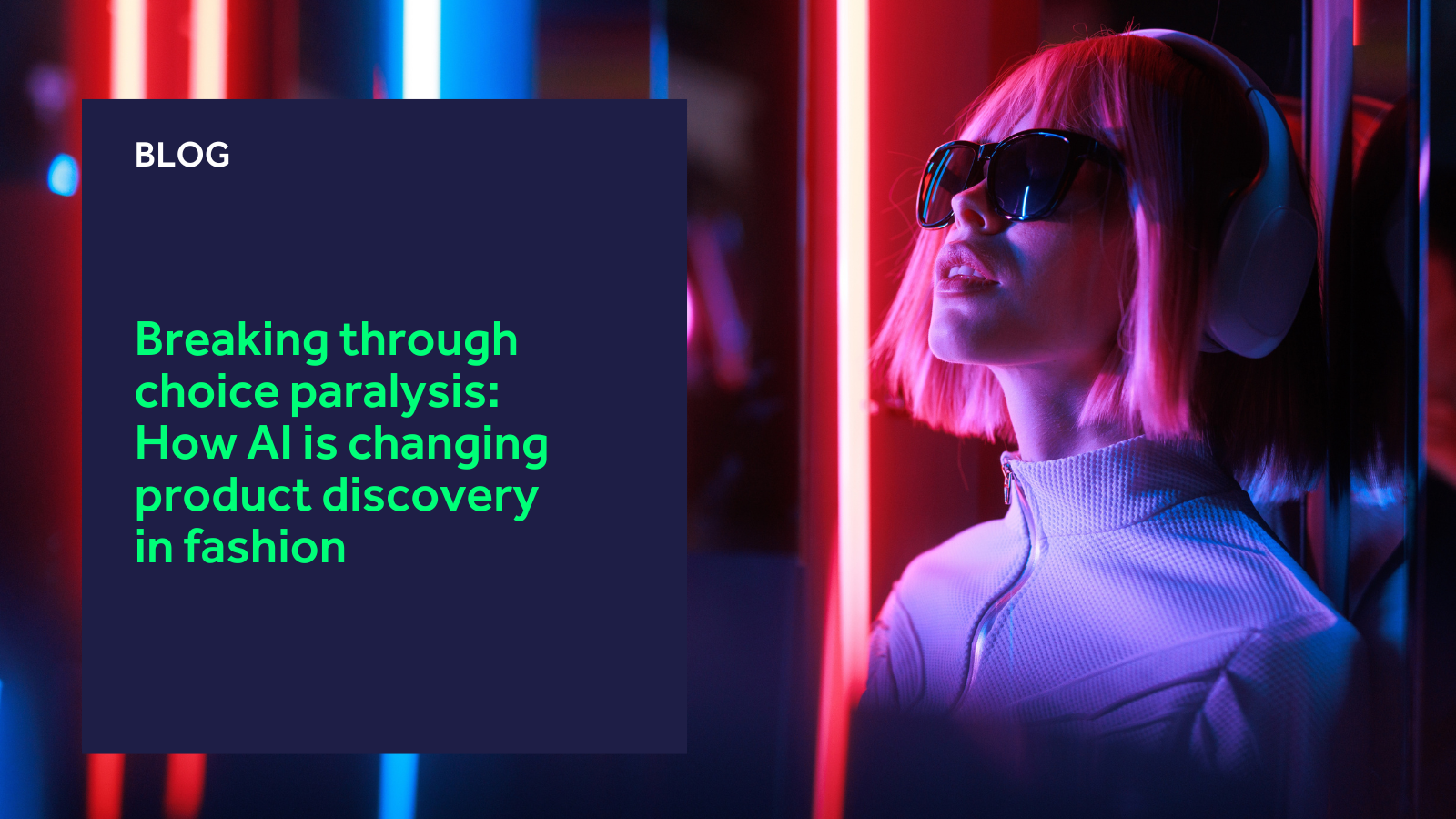We’ve all been there… browsing a cool fashion brand’s site only to be met with thousands and thousands of product listings. There’s so much to choose from – what do we pick!?
Everyone’s experienced it. Choice paralysis. We become so overwhelmed by the abundance of options that we typically just abandon the cart altogether.
Fashion brands: this is your call to action. You’re losing out on missed sales. But AI can help.
Consumers are digitally overwhelmed
Fashion’s always moved pretty fast but newer, pureplay direct-to-consumer brands like Shein have upped the ante considerably.
The sheer volume of new products hitting digital shelves is staggering with estimates suggesting that Shein alone adds up to 10,000 new items every, single day.
This rapid-fire approach to fashion has changed the digital shopping landscape for shoppers.
Consumers are bombarded with options across multiple channels, from traditional eCommerce to social media storefronts, resulting in digital fatigue.
People simply don’t have the time to go through each product listing to find the one or two things they’re looking for.
McKinsey data proves that statement. Some 74% of shoppers abandon purchases due to overwhelming options, while 80% are frustrated with their online search experiences.
Clearly, brands need to overhaul the way their consumers discover their products.
AI – the new way to discover products?
Much in the same way that companies are using AI to sort through copious amounts of data, brands can deploy the tech to help improve searchability on their websites.
The principle is straightforward. AI acts as a personal shopping assistant, understanding context and preferences to surface relevant products quickly.
Traditional search systems rely on exact keyword matches, often missing the nuances of fashion terminology and trending styles.
AI discovery takes this further. For example, it can understand that a shopper looking for a “summer wedding guest dress” may also be interested in “occasion wear” or “formal dresses” even if they haven’t used those specific terms.
Shoppers can simply enter key search terms and AI will browse a brand’s listings and pull up all relevant items.
Over time, the technology will also adapt to each customer’s browsing patterns, learning from their interactions to deliver increasingly personalised results.
With this in mind, it’s no surprise that 50% of fashion executives see product discovery as the top use case for AI, nor that 82% of customers want AI to reduce their research time.
Connecting the customer journey to inventory decisions
One lesser talked about element in all this is that AI can also change the way merchandisers work behind the scenes.
Each customer interaction is effectively an insight that brands can use to shape their inventory management decisions.
When someone searches a brand’s site, they’re telling the brand exactly what they want.
Those searches might reveal emerging trends, seasonal shifts in demand, or gaps in the brand’s current product range.
Combine this information with purchase data and these signals become powerful predictors of future demand.
On the topic of demand shifts, social commerce has complicated the picture somewhat for brands.
Platforms like TikTok have created a new reality where a single viral post can drive thousands of people to search for specific products.
While this can be highly profitable for brands, there is a problem in that traditional inventory planning can’t keep pace with these sudden, explosive spikes in demand.
In fact, fashion brands worldwide were left holding 2.5 to 5 billion excess items (worth $140 billion) in 2023 due to poor inventory management practices.
It’s a clear sign that brands need to change how they predict and manage stock levels.
Copilot – fashion’s new merchandising assistant
To fix this, AI tools like Copilot can be deployed to work seamlessly within fashion ERPs like K3’s on Dynamics 365.
Copilot isn’t just another planning tool, it’s an AI assistant that understands the interplay between customer behaviour and stock management.
Merchandisers can now have natural conversations with their data.
Instead of painfully looking through spreadsheets, they can ask straightforward questions like “Which colours of summer dresses should we stock more of in our London stores?”
Copilot analyses historical sales data, current trends, and regional preferences to provide clear recommendations that merchandisers can use.
This capability becomes particularly valuable when managing social media-driven demand spikes.
Copilot can detect unusual patterns in search activity and automatically flag potential trends, giving merchandising teams time to adjust stock levels before demand outstrips supply.
Turn choice paralysis into an advantage
Choice paralysis isn’t new, but AI is finally giving us the tools to tackle it properly.
By connecting customer behaviour with smarter inventory management, brands can offer plenty of choice without overwhelming shoppers.
The key lies in making these vast product catalogues work for both customers and brands.
AI-powered discovery helps customers find exactly what they want, while tools like Copilot ensure those products are available when and where they’re needed.
It’s a twin approach that changes choice from a negative impact on the bottom line to a positive one.
It results in less abandoned carts, less excess stock and ultimately healthier profit margins.
Interested in learning more about K3’s solutions and Copilot? Feel free to drop us a line today.
 https://www.k3btg.com/wp-content/uploads/2024/03/K3-strengthens-global-market-position-blog-header.png
900
1600
Jordan Heal
https://www.k3btg.com/wp-content/uploads/2022/03/K3_Master_Colour_RGB.svg
Jordan Heal2024-03-11 10:58:242025-02-21 14:37:51K3 Fashion Portfolio strengthens global market position as Tony Bryant spearheads new role
https://www.k3btg.com/wp-content/uploads/2024/03/K3-strengthens-global-market-position-blog-header.png
900
1600
Jordan Heal
https://www.k3btg.com/wp-content/uploads/2022/03/K3_Master_Colour_RGB.svg
Jordan Heal2024-03-11 10:58:242025-02-21 14:37:51K3 Fashion Portfolio strengthens global market position as Tony Bryant spearheads new role

